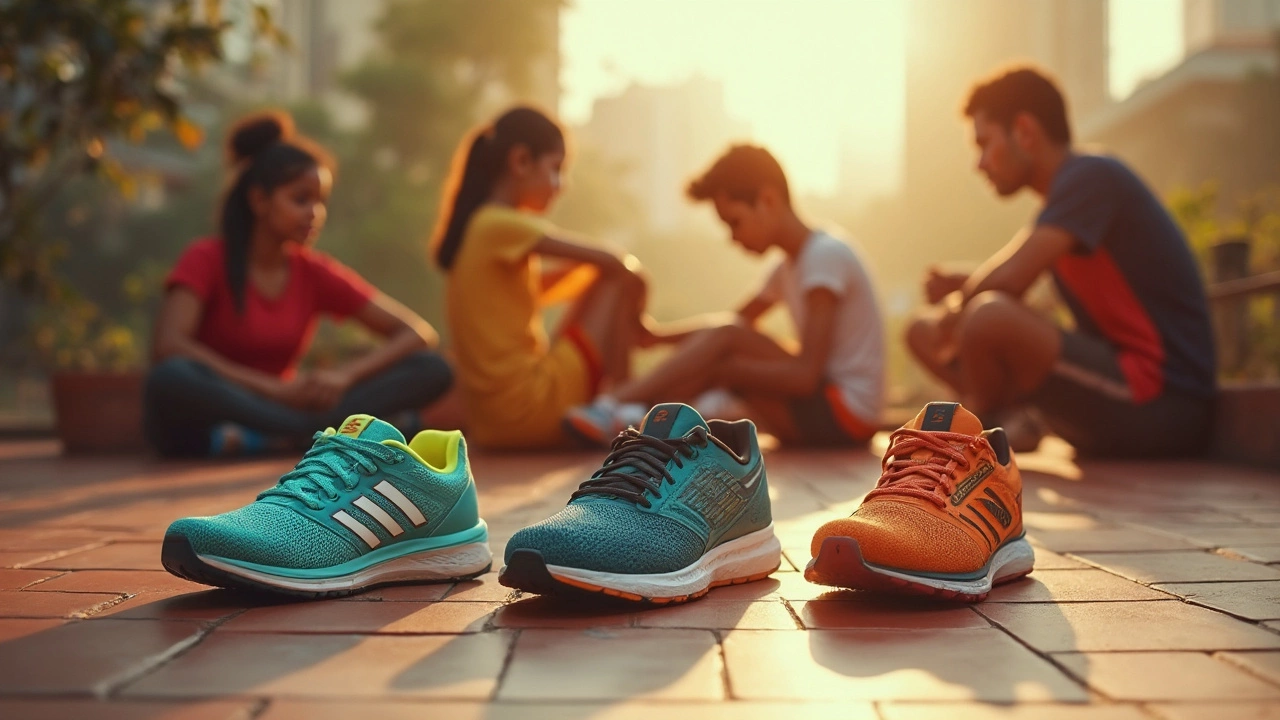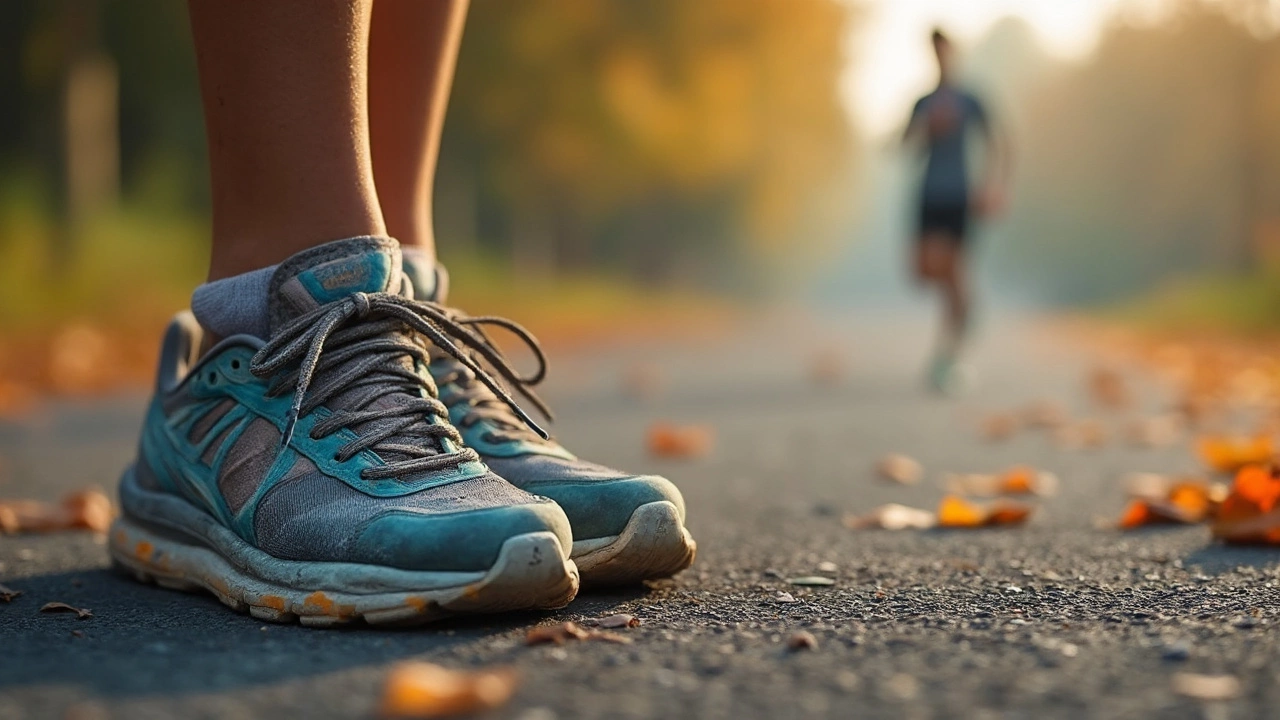You can run through sunshine, storms, or a brisk morning fog and barely notice anything—until your feet start complaining. That soft cradle for your foot that made those first few miles feel like a breeze can turn into little more than a tired slap on the sidewalk. If you’re finding yourself questioning every ache and twinge, it might be time to ask: are your shoes doing their job, or just tagging along for the ride?
The Science and Signs of Shoe Wear
First, let's talk about what really happens to your running shoes when you put mile after mile on them. The cushy feeling you get underfoot isn’t magic—it’s foam compressed by the impact of your every step. As you rack up the distance, that foam, whether it’s EVA, PU, or some branded cushioning tech, loses its giving power. Results from a 2023 biomechanics study showed that midsole foam can lose up to 30% of its shock absorption capability at just 350 miles. That means, if you’re running 20 miles a week, you can burn through a pair of shoes in 4–6 months. It sounds fast, but your body feels all those impacts that your shoes can’t absorb anymore.
So what does worn-out cushioning feel like? If your runs leave your legs feeling beat up after a distance that used to be easy, or you start waking up with aches in your shins, knees, or even hips, your shoes might not be helping you anymore. I always know Apollo, my shepherd-lab mix, will outlast me on the trail. But when I get home and my feet throb, that’s when I know I’ve pushed my shoes past their prime.
Give your shoes a hands-on inspection. Press into the midsole (the cushiony part between the sole and insole)—does it squish, or does it feel flat and hard? Check the outsole too. If you see smooth spots or holes where the rubber once was, those parts are not protecting your foot any longer. You’d be surprised how quickly a small bald patch can grow into a gaping hole with just a couple more runs. When in doubt, line up your ‘new’ and ‘old’ running shoes side by side for a before-and-after look. Is the heel worn down on one side? Is the toe frayed? Little differences are signals you shouldn’t ignore.
Here’s a handy table with details:
| Sign | What to Look/Feel For | What It Means |
|---|---|---|
| Compressed Midsole | Feels flat, less cushy | Lost shock absorption |
| Outsole Wear | Smooth or thinning tread | Poor traction/protection |
| Heel Tilt | Tilt when on flat ground | Unstable support |
| Uppers Breakdown | Tearing, holes, loose stitching | Foot not secure inside |
| Frequent Nagging Pain | New aches (shins, knees, feet) | Shoes not absorbing impact |
Don’t just rely on looks, though. Some shoes hold up in appearance but wear out where it counts—on the inside. Trust how your legs and feet feel as much as what your eyes see. A 2022 survey by the American Podiatric Medical Association found that almost 60% of recreational runners reported fewer injuries after switching to fresh shoes at recommended intervals, rather than waiting until their soles showed visible holes. Your body’s more sensitive to these changes than you think.

How Mileage and Habits Affect Running Shoe Lifespan
Not all runners chew through shoes at the same pace. That guy doing 10K races every other Sunday? His shoes might last a year. Someone training for their first marathon or running every day? He might only get a couple of months of life from the same model. The rule of thumb tossed around by shoe brands and running coaches is 300 to 500 miles per pair. But that range can swing wildly, even for one runner, depending on a mix of factors.
Your weight and running style matter. A heavier runner, or someone whose footstrike is naturally harder, can wear out foam and tread faster than a lighter, more efficient runner. If you’re like me—tall, a touch heavy, and not shy about hitting the pavement hard on downhills—expect the lower end of the mileage spectrum. If you usually land on your midfoot or forefoot, you’re spreading out the impact, so you might get extra miles out of each pair.
Surface is another biggie. Asphalt grinds down shoes fast; gravel or trails spare rubber but can shred uppers. Washing machines and high heat also eat away at glue and material, so if you get muddy, clean shoes with a brush and air dry them. Dogs can be rough too. Apollo once turned a brand-new pair into chew toys in minutes, so I learned pretty fast to stow my gear out of reach!
Shoe rotation can keep your kicks fresh longer. Don’t rely on just one pair, especially if you’re training hard. Studies out of Luxembourg in 2021 found that rotating between at least two pairs reduces injury risk by over 39%, since it lets foam recover and your feet experience slightly different patterns of stress. If you do trail running, have a trail-specific and a road-specific pair—you’ll save both shoes and your feet.
Measuring your mileage makes things easier. Some people log every run in an app like Strava or Garmin Connect. If that sounds tedious, just jot the purchase date on the box with a marker. Or, tape a note to your closet that says, "March 2025: New Blue Asics." If you run 20 miles per week, at 400 miles a pair, you’re due to swap after about 20 weeks. That’s five months—set a calendar reminder and trust it.

What Happens If You Don’t Replace Your Shoes?
This might sound dramatic, but running in worn-out shoes is like driving a car with no shock absorbers. You might not feel it at first, but over time, things start to rattle and wear out. Your feet take the first hit. Without proper shock absorption, you’re doubling (or even tripling) the stress on your ankles, knees, shins, and hips. The repetitive pounding adds up, leading to everything from plantar fasciitis (that nagging heel pain) to shin splints or even stress fractures if you keep pushing.
It doesn’t stop at injuries. Running in dead shoes forces your body to move in awkward ways to compensate for lack of support, potentially messing with your stride and running efficiency. One meta-analysis published in the Clinical Journal of Sports Medicine in 2023 found that runners who ignored obvious signs of worn shoes reported up to 1.7 times more overuse injuries than those who replaced shoes proactively. They also reported more days lost to injury and recovery—a real bummer if you’ve got a race on the calendar or a streak to protect.
Besides the medical risks, old shoes can kill your motivation. If every run starts or ends with sore feet, you’ll find yourself making excuses to skip. Running should feel good and almost effortless some days—the right shoes are half that battle. If you’re just getting back into running or training for something big, treat new shoes as an investment in your enjoyment and success, not just a necessary expense.
But don’t fall for every marketing gimmick. Some brands love hyping new tech that promises everlasting bounce, but wear-and-tear tracks pretty closely to those 300–500 mile estimates, regardless of the latest material breakthrough. That said, high-end shoes can feel better for longer, but after 400–500 miles, they too lose their magic.
Got an old pair you’re sentimental about? You don’t have to toss them immediately. Retire them from running and use them for errands, walking the dog, or mowing the lawn. Just make sure your next training run starts fresh. Watching Apollo do zoomies across the park reminds me — the right gear doesn’t just let you keep up, it lets you keep enjoying the journey. Keep an eye on your shoes, and your runs won’t just last—they’ll stay a pleasure.
